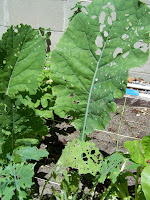Something was eating my collards...but what are a few holes in the leaves among friends? UNTIL - there were more holes than leaves...

Upon turning over a leaf (not a new one...just an old one) I saw one of the culprits - a small green worm like critter that was munching away at my collards.

Well, I had seen some white cabbage moths flitting around a week so before...I fed those few holey leaves to my chickens and they just gobbled them up! They really LOVE collards!
A few days later, I was looking at the garden...and almost ALL of my collards looked like they'd been shot with buckshot! How many more cabbage moth worms are there? I didn't only find the familiar little green guys...to my complete surprise, I found a bunch of these...

Meet The Cross-Striped Cabbageworm! Kind of a pretty little thing really. The adult cross-striped cabbageworm (moth) isn't so pretty - sort of pale yellowish-brown.
So, what about it? Well, the cross-striped cabbageworm (from here on out referred to as CSC to enable me to type quicker...) are enamoured with cabbage (hence the name!), collards, turnips, cauliflower, broccoli...and any other related crops! Oh joy! I had turnips, from my hoop house, but they bolted so I ripped them out...but I still have collards and cabbage! UGH!!
Sigh...so what do these little buggers do?
Well, the larvae will eat very large oval shaped holes in the leaves and can burrow into a developing cabbage head. This would be no big deal if I had acres and acres of collards and cabbage...but not so great when you have a small veggie patch in your backyard. No wonder they just decimated everything in their path! When I found particularly infested leaves and stalks, I carefully plucked them, and fed them, leaves and all, to my chickens! My two Cochin pullets ate them like candy! Plucking them off one by one before even bothering with the greens!
But for those of you without chickens...you can hand pick the CSC's from your crops - and then DESTROY THEM!! Don't just knock them to the ground...they will find their way back. And since they can overwinter in their pupal stage, just beneath the soil...you may want to destroy all that is left after you have harvested the heads or leaves you desire. You can plow them under, but I'd prefer to destroy them. Another method, as suggested by the Rutger's Cooperative Extension is to use" parasites, predators and parasitoid wasps to help control the CSCs"...but with a small plot, hand picking will probably be sufficient, though time consuming. Using Bt can also be beneficial - if you are inclined to use pesticides.
As for me, I've pulled up my collards, fed the remaining to my chooks, and am closely watching the smaller collards and my lovely Swiss chard - that is just about ready for some harvesting...found a few on them too...luckily my chooks love greens!! And CSCs! Happy Hunting!






























